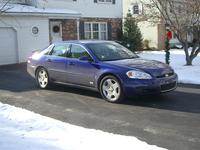2006 Chevrolet Impala SS Review
THE AUTO PAGE
By
JOHN HEILIG
SEE ALSO: New Car Buyer's Guide for Chevrolet
SPECIFICATIONS
MODEL: Chevrolet Impala SS Sedan
ENGINE: 503-liter V8
HORSEPOWER/TORQUE: 303 hp @ 5600 rpm/ 323 lb.-ft. @ 4400 rpm
TRANSMISSION: 4-speed automatic
WHEELBASE: 110.5 in.
LENGTH x WIDTH x HEIGHT: 200.4 x 72.9 x 58.7 in.
TIRES: P235/50R18
CARGO VOLUME: 18.6 cu. ft.
ECONOMY: 18 mpg city/28 mpg highway/13.4 mpg test
PRICE: $$29,980 (includes $660 destination charge)
The first official Chevrolet "Super Sport" was an option package on the 1963 Chevy II Nova Sport Coupe. That year's Impala also had "SS" equipment, which was a $161 option on the 425-horsepower V8.
Today, Chevrolet has an "SS" option for almost every vehicle it makes, and we expect to see an Aveo SS in the future if the trend continues. While the Super Sport designation made a lot of sense in the muscle-car era, and makes some sense today with emasculated power ratings for many vehicles, by rights, only the Impala should have an SS designation.
Our tester, the Impala SS sedan, is a super sport in most versions of the definition. The only caveat is that the Impala of 2006 is a front-wheel drive car, unlike the rear-wheel drive Impala SS of 1963. And while the older SS had a 425-horsepower engine, this year's version "only" has 303 horses, but they are enough to propel the Impala into the illegal speed area quickly. Too quickly.
I felt the Impala, even with its fwd, is the epitome of what a modern SS should be. It had power, it had excellent handling (probably better handling than its ancestor), great brakes, and a sweet sound emanating from its dual exhaust tips.
One problem with gobs of power in a fwd car is that there is significant torque steer when you tromp on the accelerator. You have to hold on tight to the steering wheel if you want to hit it, because the SS may want to run away with a mind of its own. But, and this is the thrill, you can leave rubber on the road even when you're in "D".
One other disadvantage of this power is low fuel economy. We averaged only 13.4 mpg, five mpg below the EPA city estimate. Granted, we didn't' use the Ss for any long trips, but I felt we could have earned a higher figure. Maybe if I had kept my foot off the floor beneath the accelerator it might have been better.
Our tester had remote start, which was a godsend in cold weather. We were returning from a bus trip with a group of people from our church, and I remote-started the Impala from inside the bus before we got off. We had been talking with a young college student, and when he got off the bus, all he could say was, "Wow." The looks and the sound, even at idle, impressed him that much. Here was a man who knew his cars (he was grilling me all the way down to Philly and back), and knew what was sitting there gurgling.
Behind the wheel there's a retro style to the instruments and even the shifter. You have to know what gear you want and how to get there because there aren't any markings next to the shifter as there are in almost every other car I've driven. Sure, there is an indicator on the instrument panel, but after a while you can shift by feel, just as you would with a stick shift.
The Impala also had a couple of nice modern features. For example, cruise control switches were on the multi-function steering wheel. No, it's not as multi-function as a Formula 1 car, but it's pretty good for a family sedan. Behind the wheel proper are switches on the right to control the audio system - volume, mode, etc. Storage areas abound. There is a nice small tray in the door pockets that convert them from being black holes to suck up all your belongings into a practical storage area. There's also a nice cubby in front of the shifter with two 12-volt outlets. Two cupholders are behind the shifter. There's also an insert tray inside the deep center console.
The HVAC system was excellent. It offered warmth on many cold evenings. The powered leather seats were also heated, which helped to warm the body before the heater kicked in. While we liked the heat in the seats, they could have offered more side support. Since the Impala SS had power, and handled very well for a car of its lineage, there could have been more side support to hold the driver and passengers in their seats. In general though, the seats were comfortable.
In addition, there was good rear legroom as well. Since the Impala's prime use is as a family car (and not in SS form), rear legroom is important. So is the trunk, which is large by modern standards at 18.6 cubic feet. The rear seat backs fold forward, but not completely. With them folded, a large connecting "hole" from the rear seat area to the trunk opens, which facilitates loading of longer objects in the trunk. This is helpful, but I prefer complete fold-downs, but Chevy never asked me during the design process.
With a bottom line of $29,320, the Impala SS is probably equivalent to what the car would have cost in 1963, figuring in inflation and all the safety measures that have been added. The Ss is top-of-the-line in a series that has base prices as low as $21,330 for an Impala equipped with a 3.5-liter V6 delivering 211 hp. That's still a pretty good value, figuring in inflation yada, yada, yada.
© 2006 The Auto Page Syndicate



